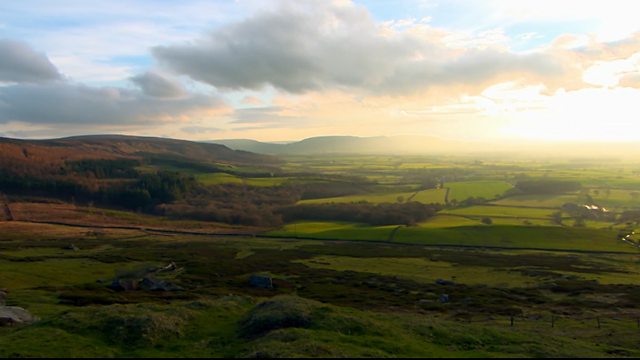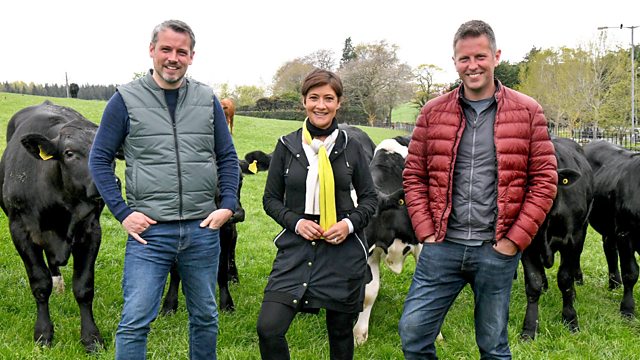Countryfile – Autumn Spectacle – In the heart of Norfolk, adjacent to the majestic expanse of the Wash, unfolds one of the UK’s most breathtaking wildlife phenomena, known fondly as the Snettisham Spectacular. Here, Joe Crowley and Charlotte Smith embark on an immersive journey, witnessing firsthand the awe-inspiring sight of countless wading birds ascending in unison against the autumn sky—a natural orchestration triggered by the season’s highest tides which disturb these creatures from their habitual feasting grounds on the rich, sprawling mudflats.
Our hosts delve deeper into this seasonal marvel, acquainting themselves with the distinctive rhythm of life that accompanies the onset of autumn in this unparalleled terrain. They navigate the intricate tapestry that interweaves both the human and natural inhabitants of this extraordinary landscape, shedding light on their symbiotic existence. Immersing himself in the thick of things, Joe courageously plunges into the viscous mud, endeavoring to uncover the magnetic allure of this region that draws such immense flocks of diverse avian species. His curiosity also steers him to a local church, where he confronts an unexpected dilemma—bats taking up clandestine residence in the belfry, presenting a complex challenge to the parish.
On the other hand, Charlotte allies with the Royal Society for the Protection of Birds (RSPB), arming herself with binoculars, and sets out on a meticulous expedition to observe the plethora of species that are irresistibly drawn to this remarkable coastal haven. Among the teeming masses, she pays special attention to the knot, a species that significantly contributes to the area’s ornithological importance. In a more contemplative vein, Tom probes into the sobering reality behind jump racing, seeking answers to the tragic demise of over a hundred horses the previous year. He delves into the future of the sport, exploring imminent plans for a comprehensive overhaul of safety measures, a step that hopes to preserve the spirit of the sport while prioritizing the welfare of its equine athletes.
Adding to the tapestry of experiences, Adam partakes in a once-in-a-lifetime escapade, guiding a boisterous herd of cattle along the sandy stretches of the iconic Jurassic coastline. This endeavor, covering an impressive two miles, not only challenges his cattle-driving skills but also highlights the diverse interactions between humans and animals in these storied landscapes. Together, through their distinct adventures, our hosts unravel the multifaceted wonders hidden in the folds of the UK’s natural heritage, presenting not just a wildlife spectacle but a profound narrative of life, coexistence, and the enduring charm of the British outdoors.
Countryfile – Autumn Spectacle
A Spectacular Wildlife Event on the Norfolk Coast
The Wash in Norfolk is home to one of the greatest wildlife spectacles in the UK – the Snettisham Spectacular. During the highest spring tides of the month, thousands of wading birds flock to the mudflats of The Wash to feed. However, as the incoming tide rises, it forces the birds off the mudflats and up into the air in a mesmerizing natural display.
In this article, we’ll explore the start of autumn on the Norfolk coast, building up to the spectacular sight of the Snettisham Spectacular. We’ll discover why so many wading birds are drawn to this location and the other wildlife and natural features that make it so unique. Join us as we journey through the landscapes, people, and animals that bring the Wash to life.
Norfolk’s Unique Landscape Shapes Its Wildlife
The Wash is a large bay with extensive wetlands and mudflats, fed by rivers including the Nene, Great Ouse, and Welland. Its unique geography and ecology make it a magnet for wildlife. The tides here have the highest range in Britain, over 7 meters. When the tide goes out, it exposes over 300 square km of mudflats – a vital feeding ground for thousands of wading birds.
The muddy sediments of The Wash contain rich invertebrates like lugworms, which birds like knots and dunlins feed on. The abrasive tidal movements also stir up food. This predictable tidal cycle allows birds to maximize their feeding. Come high tide, the remaining salt marshes and grasslands provide roosting spots.
Beyond the main mudflats, The Wash also features gravel pits, sandy beaches, and coastal lagoons. This diverse landscape supports marine wildlife, from gray seals to spiny seahorses. The variety of wetland habitats in The Wash is why it holds over 90,000 wintering waterbirds annually.
Getting Stuck into the Mud to Understand the Ecology
To understand what makes The Wash such prime feeding grounds for waders, Countryfile presenter Joe Crowley heads out onto the mudflats at low tide. He squelches through the soft sediment, which ripples as the tide recedes. Joe examines the worms and tiny mollusks that get churned up here twice daily, providing an abundant food source.
Lugworms are one of the most important invertebrates thriving in the mud – up to 4,000 per square meter. Joe digs one up, examining its red bloated body and the tell-tale casts it leaves on the surface while feeding. Such invertebrates are rich in fat and protein – ideal nutrition for migratory birds refueling on long journeys.
The rich density of these invertebrates makes The Wash the most important estuary for dunlins in the UK. Up to 400,000 spend their winters feeding on these mudflats. Joe notes you can find a dunlin every couple meters squared. He reflects on how the unique geography and tidal flows underpin this vital food chain.
RSPB Members Get Front Row Seats to the Avian Action
The Royal Society for the Protection of Birds (RSPB) has several nature reserves around The Wash, perfectly positioned to observe the migratory birds that flock here. Charlotte Smith meets with RSPB volunteer Derek Moore for a spot of birdwatching over the wetlands.
Equipped with binoculars, they head out across the salt marshes keeping their eyes peeled. Derek points out avocets with their slender upturned bills and black-and-white oystercatchers stabbing at mollusks. A flock of knots wheels over the reserve, their rapid twisting flight on pointy wings mesmerizing against the big Norfolk skies.
Derek reflects how The Wash is a birdwatching mecca, especially in autumn when migratory species arrive from their Arctic breeding grounds. He highlights how RSPB reserves allow close access to observe stunning birds like the knot. RSPB membership also supports conservation efforts for threatened species.
With high tide approaching, Derek and Charlotte head to the main hide to witness the Snettisham Spectacular. Charlotte is awed by the huge flocks as a shimmering avian cloud rises with the tide. She gains new appreciation for the global importance of The Wash for these epic migrations.
Achieving a Bird’s Eye View of the Spectacular Mudflats
While the RSPB offers front-row seats to the avian action, learning to identify key species gives a new perspective. Derek teaches Charlotte about some of the iconic birds that call The Wash home.
The knot is a highlight, a robin-sized wading bird that migrates in huge flocks from Arctic Canada and Greenland. In flight, their compact flocks pivot in perfect unison. Derek points out their grey winter plumage, distinctive on flashed underwings, and energetic flight style.
Oystercatchers are year-round residents, identified by their orange bills and black-and-white plumage. Avocets stand out with slender upturned bills for sweep feeding. Black-tailed godwits have long bills suited to probing mud while dunlins are energetic little waders constantly darting about. Equipped with this knowledge, Charlotte gains a new appreciation of the differences between the kinetics, shapes and plumage of the myriad birds that congregate here.
Spectacular Scenes as Birds Lift Off at High Tide
As the tide rises across the mudflats, the pods of feeding birds grow restless. Finally, the water forces the birds off their feeding grounds entirely. Derek and Charlotte are perfectly positioned to witness the ensuing mass exodus.
As if on cue, enormous flocks climb into the skies, wheeling and swirling in tightly synchronized patterns. Oystercatchers, knots, godwits and dunlins take to the air as one. It’s a sight of raw natural wonder, these thousands of birds moving as one churning cloud.
Derek explains how perfectly adapted these birds are to maximize feeding efficiency across the tidal cycles. Their upward mobility allows them to wait out high tide when the mudflats become inundated. Charlotte is blown away by the spectacle of so many birds appearing to move as one seamless organism.
This daily tidal dance highlights the synchronicity between The Wash’s ecology and its birdlife. The rising and falling tides are the metronome keeping time for this site of global importance for migratory waders.
The Event Draws Birding Tourists from Around the World
For devoted birdwatchers, witnessing the Snettisham Spectacular is a bucket list aspiration. Each year, thousands of tourists flock to North Norfolk to witness this wildlife phenomenon. Quad bikes, bicycles and cars jam the coastal roads near Snettisham as crowds stake out spots.
Of course, RSPB reserves offer front row seating. For those without memberships, there are areas around the RSPB sites to array binoculars and telescopes. Arriving hours before high tide is advisable to secure a good vantage point. Some even camp overnight to get the best bird sightings.
Beyond the Snettisham area, other Wash hotspots to observe the action include Titchwell Marsh RSPB and Frampton Marsh. Patience and research on tide times are key. As the tide completes its cycle, the birds return to the mudflats, dispersing inland or onto the sea.
While the Snettisham Spectacular only occurs on the highest tides, the RSPB reserves offer fabulous birdwatching year-round. Even on an average day The Wash hums with avian life, its riches revealed through learned eyes.
Discovering the Ancient History Written in The Wash’s Soils
While the biodiversity above ground in The Wash is exceptional, clues to the past also lie buried below. Joe Crowley meets with a team of archaeologists digging on the coastal fringes, seeking artefacts preserved in the wet soils.
At low tide, the archaeologists spread across newly exposed sediments, detecting traces of past human activity. Joe is excited to discover fragments of 2000-year-old pottery plus chunks of ancient peat. One piece bears the imprint of an elm leaf, a lost landscape buried beneath the encroaching sea.
Joe learns how artifacts can remain sealed in these anaerobic soils. The constantly shifting tides can then reveal long lost remnants. Finds here range from prehistoric forests to Roman salt workings. Joe reflects on how entire human settlements now lie drowned beneath the sea.
The archaeologists explain how the receding coastline can help peel back layers of history but also accelerates the loss of sites. Rising seas catalyzed by climate change now threaten to inundate the buried stories of The Wash. Urgent recording work races to unlock clues that may soon be drowned forever.
Balancing Conservation with Modern Industries
While The Wash is famed for its ecological richness, it is still a working landscape. Fishermen harvest cockles, shrimp and seafood from its waters. Joe joins local fisherman Shane aboard his boat to get a sense of modern maritime life.
Shane reflects on generations of his family working these seas, describing sustainable fishing practices balancing livelihoods with conservation. Joe helps sort through their trawl, identifying crabs, flatfish and more. He’s surprised to learn endangered eels are also fished and exported live to the Netherlands.
A few miles inland, vast fields of vegetables like potatoes and cauliflowers stretch across the Fens. Charlotte meets Fen farmers who cultivate the peaty soils, although climate change poses challenges with both droughts and floods. Charlotte also visits huge poly-tunnels growing ornamental plants destined for garden centers nationwide.
Both traditional industries, from fishing to farming, must coexist alongside the needs of migratory birds and precious habitats. By understanding this interconnectivity, the gifts of The Wash can be sustained through future generations.
Trouble in the Belfry: Bats Suffer at Saxon Churches
Beyond the coast, Saxon-era churches are a cultural landmark of Norfolk. The problem? Several are infested with bats in their belfries and attics. Joe visits St Margaret’s Church in Cley-next-the-Sea to learn about solutions balancing religious and ecological needs.
He meets the church warden and a bat conservationist surveying the population. Hundreds of endangered soprano pipistrelle bats roost here. While legally protected, their acidic droppings damage irreplaceable Medieval features.
Joe climbs the bell tower in a hard hat to witness the bats firsthand. Their high-pitched echolocation signals a dizzying aerial display at dusk. The conservationist explains possible remedies, from installing bat boxes to netting off sensitive areas.
A careful compromise is needed to allow worship yet protect the bats. The conservationist reflections how old churches can provide vital habitat as modern roosting spots dwindle. Their stone nooks and crannies offer stable temperatures, allowing bats to save energy while hibernating or rearing young.
Joe comes away with deeper insight into how conservation requires understanding things from all perspectives – even when in conflict. By seeking solutions agreeable to both parties, precious aspects of both cultural and ecological heritage can be preserved.
Iconic Coastline: Driving Livestock Along the Jurassic Coast
While Norfolk boasts sublime intertidal habitats, England’s south coast has its own claim to natural wonder: the Jurassic Coast. Spanning 96 miles of shoreline, it encompasses 185 million years of geological history across Triassic, Jurassic and Cretaceous rock formations.
Adam Henson gets a chance to experience this coast up-close, taking part in an ancient livestock tradition. He meets up with a farmer moving his cows and calves between coastal pastures, using beaches as drove roads at low tide.
Together, they encourage the herd down seaside ramps onto Chesil Beach. Adam revels in the joyful chaos of hooves on sand, dogs barking and livestock lowing as they amble along the iconic shingle bank.
After 2 miles, the herd exits and makes its way inland. Adam reflects on how previously pedestrian methods endure as sustainable practices. The cows gain great grazing while avoiding damage to cliff roads. It highlights age-old wisdom balancing human needs with coastal ecology through generations.
Jump Racing Reconsiders Safety to Protect Noble Horses
Horse racing sees critiques over animal welfare, including fatal injury rates. Tom Heap investigates one discipline, jump racing over fences, talking to those working to improve safety and transparency.
He visits leading trainer Paul Nicholls. Tom learns how improvements in nutrition, training and breeding better protect thoroughbreds. Nicholson explains how tracks have invested in superior maintenance and obstacle design to reduce falls.
Retiring horses too young also raised issues. Now horses race until maturity, strengthening bones and muscles for hurdling. Tom visits a retraining center transitioning ex-racers to new careers, like polo and dressage. Their versatility is a testament to the breed’s nobility.
Reforms address horse fatalities, which nationally fell 15% from 2020 to 2021. However, transparency and consistency in reporting remain imperfect between tracks. Ongoing dialogue and research are still vital to uphold these majestic animals’ welfare within a historic sport.
The Wash: A Vital, Threatened, Yet Unifying Landscape
The myriad habitats of The Wash, from intertidal mudflats to inland Fens, support an interconnected web of life. Its riches stem from diverse wetlands forged over centuries of changing seas and human hands.
Yet climate change now threatens these habitats and heritage. As explored on Countryfile, the perspectives of conservationists, archaeologists, farmers and more must unite to meet this challenge. Only by bridging divides can a sustainable future be charted in which nature and people thrive together.
From exquisite birds lifted aloft by rising tides, to buried human stories revealed then concealed by shifting sands, The Wash offers powerful lessons. This place teaches the value of community alongside ecology for safeguarding treasures that stretch from present day back through millennia.
Frequently Asked Questions – Countryfile – Autumn Spectacle
What makes The Wash such an important habitat for migratory birds?
The Wash’s extensive mudflats and saltmarshes provide ideal feeding and roosting habitat for migratory birds. Its intertidal areas are rich in marine invertebrates, an abundant food source for waders. The large tides also give birds synchronized access across tidal cycles.
When is the best time to see the Snettisham bird spectacle?
The biggest flocks lift off around the highest “spring” tides, especially in the autumn migration season from late September to early December. Arrive 2 hours before the predicted high tide for prime viewing.
Where are the best places to see the Snettisham bird spectacle?
The RSPB Snettisham reserve offers great birdwatching infrastructure like hides. Other spots along the coast also work if you arrive early to stake out positions. Be respectful of nesting birds if going off trail.
How does climate change threaten the biodiversity and heritage of The Wash?
Rising seas and extreme weather threaten vulnerable coastal ecosystems. Increased flooding accelerates erosion, destroying feeding grounds and nesting sites while inundating archaeological sites.
How can sustainable practices balance economic needs like farming and fishing alongside conservation?
Methods like careful seasonal grazing regimes, low-impact fishing gear, protecting habitat buffers and managing tourism access can allow measured, thoughtful use supporting local livelihoods.




